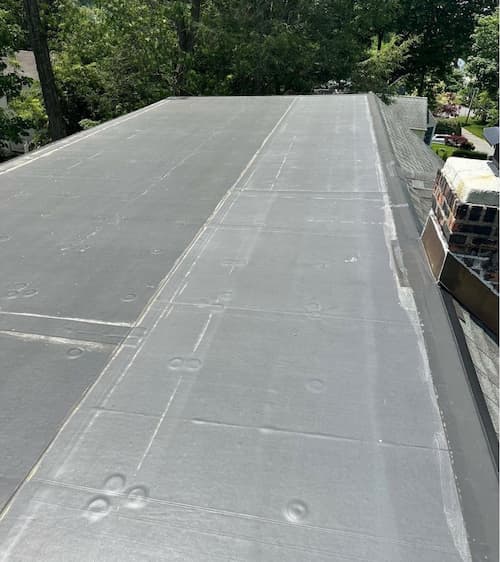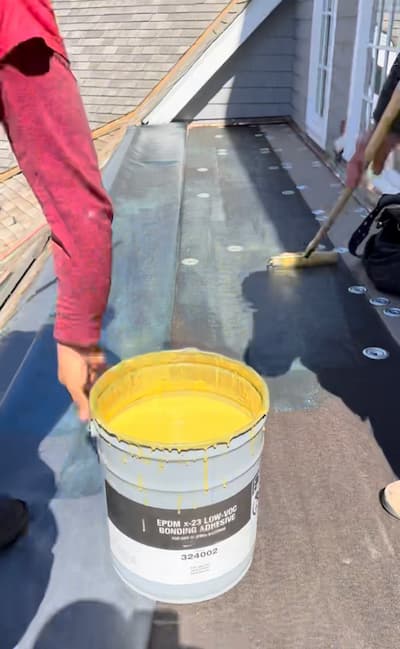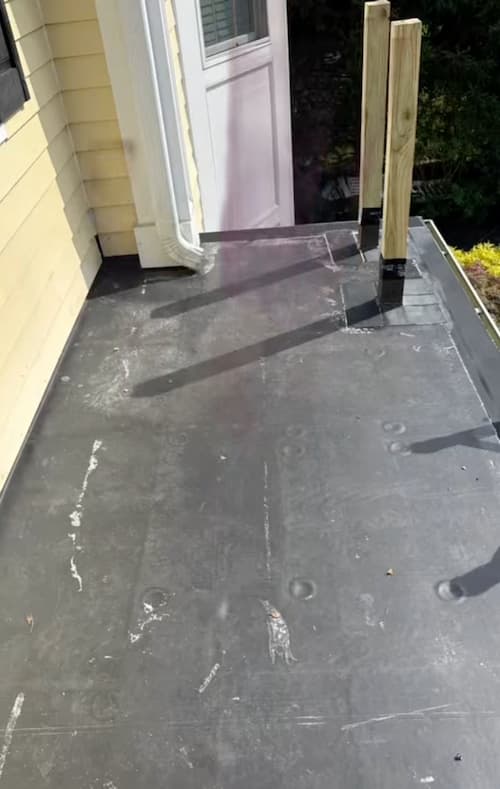Flat Roofing New Haven County, CT

EPDM Flat Roof Installation New Haven County, Connecticut.
Flat Roofing
We are EPDM flat roof installation experts. Flat roofs are made from membrane roofing material. They are integral to specific architectural styles and have been popular for commercial applications for decades. This durable roofing material is being used on residential homes in our area with fantastic results.
Membrane roofs have been a popular solution for low-slope and flat roofs for decades. Now, this material is being used in more residential applications with fantastic results.
Flat Roofing Repair
How can we help?
George’s Seamless Gutters takes pride in our reputation as an elite-level gutter installation and roofing company.
Get Started
We are here to answer any questions
Residential FLAT ROOFING
For decades, membrane roofing has been a top choice for commercial buildings or any structure with a low-slope roof pitch of less than 2:12.
These roofs have minimal incline, causing water to pool rather than run off. This poses a waterproofing challenge, ruling out many common roofing materials like asphalt shingles, which, per building codes, need to be more suitable for low-slope roofs.
EPDM roofing and similar flat roofing systems are solutions in situations where roofs are low-slope or even flat.
EPDM Flat Roofing Systems


EPDM stands for Ethylene Propylene Diene Monomer, and this roofing material option is an exceptionally durable synthetic rubber membrane used on flat roofs. EPDM is used extensively on low-slope buildings in Connecticut, and worldwide. Its remarkable durability sets EPDM apart, making it a preferred choice for a wide range of roofing applications.
EPDM is durable and waterproof, making it ideal for these architectural challenges. Whether you need to protect the entire roof or specific low-slope sections, EPDM roofing ensures your commercial building remains safe from water intrusion.
FLAT ROOFING New Haven county, ct

Flat roofing is used on low-slope roofs and is commonly seen in homes and buildings with modern architecture, homes with a lower profile, and home additions and extensions. Flat roofing has some definite advantages. Flat roofing is generally less expensive to construct and maintain than pitched roofs, as flat roofs are more accessible, making maintenance tasks, repairs, and inspections more straightforward compared to steeply pitched roofs.
While Flat roofs are often called for in specific architectural and construction scenarios, they are also sometimes chosen for their unique advantages. Here are some situations in which a flat roof might be appropriate:
- Commercial and Industrial Buildings: Flat roofs are commonly used in commercial and industrial structures due to their cost-effectiveness and the practicality of placing HVAC equipment, solar panels, and other utilities on the roof.
- Urban Environments: In densely populated urban areas, flat roofs can maximize usable space by creating rooftop gardens, terraces, or outdoor recreational areas.
- Solar Panel Installation: Flat roofs provide an ideal platform for installing solar panels, as they offer a level surface that can effectively capture sunlight.
Amy Foxman
(Verified Google Review)
Matt S.
(Verified Google Review)
Susan Lind
(Verified Google Review)
EEC
(Verified Google Review)
Sam Shams
(Verified Google Review)
Frequently asked Flat Roofing Questions
What Causes Flat Roofs to Leak?
Like all roof leaks, flat roof leaks can stem from any number of issues. Since all roofing leaks are unique, it is important to have a qualified roofer identify the root cause of your flat roofing leak.
Roof leaks are common, and there is no need for panic; with flat roofs, most leaks originate from the areas where pipes or vents penetrate the roof’s surface. To remedy this, your roofer will likely apply additional flashings or caulking to seal these areas and prevent further leaks.
Additionally, flat roofs are susceptible to cracking due to their direct exposure to the sun, even though they are covered with a layer of asphalt. The intense heat from the sun often dries out the asphalt, causing it to become brittle and susceptible to cracking, which, in turn, can result in leaks.
Therefore, it is essential to address cracking issues promptly by applying a new roof coating to maintain the integrity of your flat roof.
What Roof Pitch is Suitable for a Flat Roof?
Flat roofs hit their optimal performance at a low pitch.
Here in New Haven County, particularly on modern-style homes, we are seeing roofers improperly apply asphalt shingles in situations that are not suitable.
As a rule of thumb, asphalt shingles should only be employed on roofs with a pitch more excellent than 3/12 (equivalent to 14 degrees).
If your roof has a slope less than a 14-degree angle, opting for a flat roofing system instead is the most appropriate solution for your roof.
However, it’s crucial to ensure that the areas requiring a flat roof coating are installed correctly, as improper installation can lead to drainage issues that may compromise your roof’s longevity and performance in the long run—that is why our gutter and water management experts are uniquely well-suited to flat roofing work. We understand how to manage water and keep it moving down and away from your home.
How do Flat Roofs Drain?
Flat roof drainage is managed through a slight slope, drainage points, scuppers, and sometimes gutters. Regular maintenance and professional advice are essential to ensure water flows away from the roof effectively and prevents ponding.
How do you maintain a Flat Roof?
To effectively maintain your flat roof here in New Haven County, we suggest conducting biannual inspections, clearing debris, and ensuring drainage systems are unobstructed. Address any damage or drainage issues promptly, maintain gutters, trim overhanging branches, and monitor and recoat the roof as needed.
Schedule regular professional inspections, keep comprehensive maintenance records, and promptly attend to any issues that arise. Proactive maintenance is always best for flat roofs’ long-term performance.
EPDM vs TPO Roofing
TPO, short for thermoplastic polyolefin, combines ethylene-propene and polypropylene. It’s a popular single-ply roofing choice, similar to EPDM, made from eco-friendly rubber and synthetics, creating a durable roof layer.
TPO comes in different thicknesses, affecting its longevity, which is about 20+ years, while EPDM can last 50 or more. However, TPO is relatively new, so its long-term performance is still being determined.
EPDM and TPO differ in several ways:
- TPO seams are heat-fused; EPDM uses seam tape.
- TPO reflects sunlight; EPDM absorbs heat.
- EPDM comes in black or white; TPO offers more color options.
- EPDM is mechanically fastened, and TPO is chemically adhered.
- TPO warranties are 10-20 years; EPDM is usually 25-30 years.

